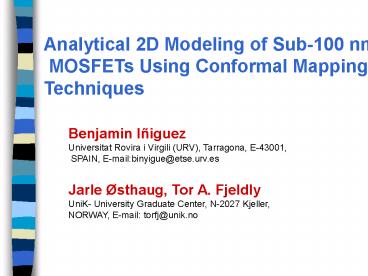PRESENTACIN DEL CV, PROYECTO DOCENTE Y PROYECTO DE INVESTIGACIN - PowerPoint PPT Presentation
1 / 15
Title:
PRESENTACIN DEL CV, PROYECTO DOCENTE Y PROYECTO DE INVESTIGACIN
Description:
... of the 2D distribution of the longitudinal electrical field in the device. ... Comparison between experimental (symbols) and modeled (solid lines) results. ... – PowerPoint PPT presentation
Number of Views:106
Avg rating:3.0/5.0
Title: PRESENTACIN DEL CV, PROYECTO DOCENTE Y PROYECTO DE INVESTIGACIN
1
Analytical 2D Modeling of Sub-100 nm MOSFETs
Using Conformal Mapping Techniques
Benjamin Iñiguez Universitat Rovira i Virgili
(URV), Tarragona, E-43001, SPAIN,
E-mailbinyigue_at_etse.urv.es Jarle Østhaug, Tor
A. Fjeldly UniK- University Graduate Center,
N-2027 Kjeller, NORWAY, E-mail torfj_at_unik.no
2
- Need of new compact MOSFET modeling concepts
- The behavior of sub-100 nm MOSFETs is critically
determined by physical mechanisms that are not
observed in larger devices. - To allow circuit designers to use the potentials
of sub-100 nm technology, these mechanisms must
be formulated and implemented into CAD tools.
3
- Need of a 2-D compact model
- The present MOSFET standard models are based on a
1D theory, initially developed for long-channel
devices. - Short channel effects have been progressively
included (as the feature size has been shrunk
down) using additional equations (often
empirical). - This has resulted in an enormous increase of the
number of parameters.
4
- Purpose of our compact modeling work
- We present a new modeling approach for nanoscale
MOSFETs, in order to derive a model based on a
careful consideration of device physics. - The scalability property is therefore inherent to
the model, therefore provoking a dramatic
reduction of the number of parameters with
respect to standard models.
5
- New 2D approach
- Our new approach is based on a self-consistent
solution of the 2D distribution of the
longitudinal electrical field in the device. - Using this approach, short-channel effects and
scaling properties are intrinsic to the model. - As a consequence, only a minimum set of
parameters with clear physical meaning is needed,
and a close accord is established with the
fabrication process. - This 2D strategy allows to obtain accurate
scaling properties of key parameters, such as
threshold voltage and subthreshold current.
6
2D Strategy
- Our method is based on separating the 2D
potential distribution in the depletion region
under the gate into that corresponding of a 1D
Poissons equation and that of a Laplacian with
well defined boundary conditions. - The Laplacian equation is solved using conformal
mapping. - Our method has been applied to classical and SSR
bulk MOSFETs - The method can easily be adapted to SOI MOS
structures (including DG MOSFETs and FinFETs)
7
2D Strategy
- We consider a bulk MOSFET in which the contact
regions are approximated by rectangular boxes and
the potential distributions in the drain and
source depletion regions are calculated using
Poisson 1D. - The MOSFET structure is split into three regions.
In region 1, under the gate the 2D potential
distribution is separated into a component
corresponding to 1D Poissons equation and a
Laplacian. - The potential distribution has to be determined
from the normal electric field En(x) which points
to region 1 from the channel. It is split into a
contribution E0 coming from a 1D analysis and a
contribution E2D(x), coming from a 2D analysis. - Once En(x) is determined, we will be able to
obtain the potential in the channel, which in
turn, will allow us to derive the threshold
voltage VT and the subthreshold current Isub
8
2D Strategy
Schematic MOSFET geometry
Boundary conditions for the Laplacian of Region
1.
9
Conformal mapping
- To solve the Laplacian, we perform conformal
mapping of region 1 into the upper half of the
(u,v) complex plane (using Schwartz-Christoffel
transformation) - It will be easier to find in that plane the
potential distributions, because of the relative
simplicity of the boundary conditions in it.
10
Conformal mapping
Along the u-axis
11
Conformal mapping
- This mapping, together with some approximations,
allows us to obtain an analytical expression of
the component E2D(u) of the Laplacian, which
results in an analytical expression of E2D(x). - Therefore, we obtain an expression of the
potential distribution in the channel, which
allows us to derive analytical expressions of the
threshold voltage and the subthreshold current
12
Results
(b)
(a)
Comparison between experimental (symbols) and
modeled (solid lines) results. Bulk MOSFETs with
Ns 2x1017 cm-3 and tox 8.6 nm (a) Threshold
voltage variation with VDS (b) Threshold voltage
variation with channel length at VDS0.05 V.
13
Results
Model calculations of the channel potential in
70 nm SSR MOSFET relative to the substrate for
(a) VDS 1.6 V at VGS 0 V (lower curve), 0.1
V (middle curve), and 0.31 V (upper curve),
Model calculations of the channel potential
relative to the substrate for VDS 0.05 V and 3
V for gate lengths of 210 nm and 250 nm and tox
8.6 nm
14
Results
Experimental (symbols) and modeled (lines)
subthreshold transfer characteristics for a 70
nm SSR MOSFET with tox 3nm. VDS 0.1 V
(lower curve) and 1.6 V (upper curve).
Measured (symbols) and modeled (line) of the
subthreshold transfer characteristic for a 250
nm MOSFET with and tox 5.6 nm at VDS 0.05 V.
15
Conclusions
- We have developed a closed-form 2D modeling
technique for sub-100 nm MOSFETs - The technique is based on conformal mapping,
where the 2D Poissons equation in the depletion
regions is separated into a 1D long-channel case
and a 2D Laplace equation. - With a minimal parameter set, the present
modeling reproduces both qualitatively and
quantitatively the experimental data of
deep-submicron and sub-100 nm bulk MOSFETs - Our technique can be extended to SOI MOS
structures































